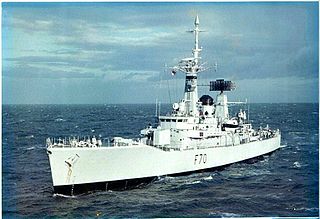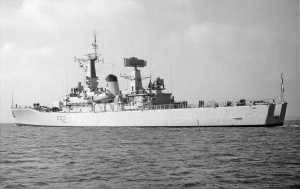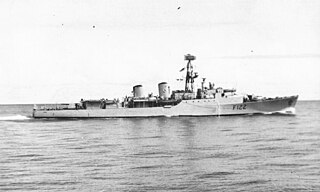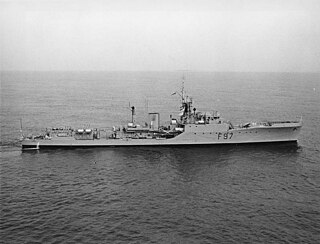The Cod Wars were a series of 20th-century confrontations between the United Kingdom and Iceland about fishing rights in the North Atlantic. Each of the disputes ended with an Icelandic victory.

The Type 14 Blackwood class were a ship class of minimal "second-rate" anti-submarine warfare frigates. Built for the Royal Navy during the 1950s at a time of increasing threat from the Soviet Union's submarine fleet, they served until the late 1970s. Twelve ships of this class served with the Royal Navy and a further three were built for the Indian Navy.

HMS Andromeda was a Leander-class frigate of the Royal Navy. She was built at HM Dockyard Portsmouth. She was launched on 24 May 1967 and commissioned into the Royal Navy on 2 December 1968. She took part in the Falklands War. She was sold to India in 1995, for use as a training ship, being renamed INS Krishna. She was finally decommissioned in May 2012.

HMS Charybdis (F75) was a Leander-class frigate of the Royal Navy (RN). She was built by the Harland & Wolff company of Belfast, and was the last ship to be built there for British naval forces until RFA Fort Victoria of the Royal Fleet Auxiliary, was launched in 1990. Charybdis was launched on 28 February 1968 and commissioned on 2 June 1969. Her nickname was "Cherry B".

HMS Diomede (F16) was a Leander-class frigate of the Royal Navy. She was built by Yarrow Shipbuilders in Glasgow. Diomede was launched on 15 April 1969 and commissioned on 2 April 1971. In 1998, the vessel was taken out of service and sold to Pakistan. Renamed PNS Shamsheer, the vessel served with the Pakistan Navy until being scrapped.

HMS Aurora was a Leander-class frigate of the Royal Navy (RN). Like other ships of the class, Aurora was named after a figure of mythology, Aurora being the Roman equivalent of the Greek goddess Eos.

HMS Leander (F109) was the nameship of the Leander-class frigate of the Royal Navy (RN). She was originally intended to be part of the Rothesay class and would have been known as Weymouth. Leander was, like the rest of the class, named after a figure of the classical Greek mythology. She was built by the Harland & Wolff shipyard in Belfast, Northern Ireland and was launched on 28 June 1961. She was commissioned on 27 March 1963.

HMS Euryalus (F15) was a Leander-class frigate of the Royal Navy (RN). Like the rest of the class, Euryalus was named after a figure of mythology. Euryalus was built by Scotts Shipbuilders of Greenock. Euryalus was launched on 6 June 1963, and commissioned on 16 September 1964.

HMS Naiad (F39) was a Leander-class frigate of the Royal Navy (RN). Like the rest of the class, Naiad was named after a figure or figures of mythology, in this case the Naiads of Greek mythology. Naiad was built by Yarrow Shipbuilders of Scotstoun. She was launched on 4 November 1963 and commissioned on 15 March 1965.

HMS Apollo was a batch 3B broadbeam Leander-class frigate of the Royal Navy. She was, like the rest of the class, named after a figure of mythology. Apollo was built by Yarrow Shipbuilders of Scotstoun. She was launched on 15 October 1970 and commissioned on 28 May 1972, making her the penultimate Leander.

HMS Ariadne was a Leander-class frigate of the Royal Navy. She was launched in 1971, was sold to Chile in 1992 and sunk as a target hulk in 2004.

HMS Juno was a Leander-class frigate of the Royal Navy (RN). Like the rest of the class, Juno was named after a figure of mythology. She was built by Thornycroft of Woolston, Hampshire. Juno was launched on 24 November 1965 and commissioned on 18 July 1967.

HMS Tartar (F133) was a Tribal-class frigate of the Royal Navy (RN). She was named after the Tartar people, most of whom were located in Asia and Eastern Europe. She was sold to the Indonesian Navy in 1984 as KRI Hasanuddin (333).

HMS Gurkha (F122) was a Tribal-class frigate of the Royal Navy. She was named after an ethnic group located in Nepal, and who continue to serve in the British Army. She was sold to the Indonesian Navy in 1984 and renamed KRI Wilhelmus Zakarias Yohannes (332).

HMS Duncan, launched in 1957, was the fifth RN ship named after Admiral Adam Duncan. She was a Blackwood-class frigate of the Royal Navy that served in the Cod Wars.

HMS Lincoln (F99) was a Salisbury-class or Type 61 aircraft direction frigate of the Royal Navy.

HMS Russell was one of a dozen Blackwood-class frigates of second-rate anti-submarine frigates built for the British Royal Navy during the 1950s. She was named for Edward Russell, 1st Earl of Orford, commander at the Battle of Barfleur in 1692.

HMS Falmouth was a Rothesay-class, or "Improved Type 12", anti-submarine frigate built for the Royal Navy during the 1950s. She took part in the Third Cod War in 1976, ramming the Icelandic gunboat V/s Týr. Both ships suffered extensive damage.

HMS Eastbourne was a Whitby-class, or Type 12, anti-submarine frigate of the Royal Navy of the United Kingdom.

The Overseas Patrol Squadron is a front-line squadron of the Royal Navy with responsibility for patrolling the UK's Extended Fisheries Zone, both at home and around British Overseas Territories. The squadron, with headquarters at HMNB Portsmouth, is equipped with eight of the River-class patrol vessels.




















